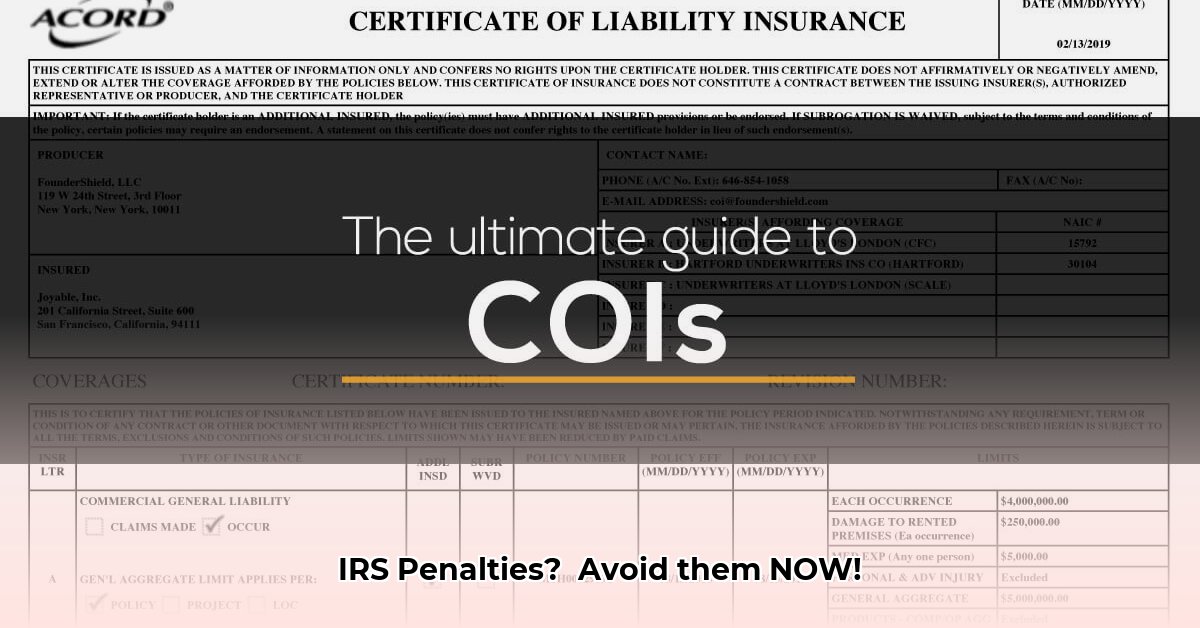
W-9 and COI: Your Guide to Smooth Sailing with Taxes and Insurance
Navigating the world of taxes and insurance can be daunting, especially when dealing with forms like the W-9 and Certificate of Insurance (COI). This guide provides clear, actionable steps to ensure compliance and avoid costly penalties. Understanding these documents is crucial for both businesses and independent contractors. Ignoring these requirements can lead to significant financial repercussions.
Key Takeaways:
- Accurate and timely completion of IRS Form W-9 is essential for independent contractors and businesses.
- A Certificate of Insurance (COI) demonstrates liability coverage, protecting both you and your clients.
- Understanding when both a W-9 and COI are required prevents potential liability issues and tax penalties.
Decoding the W-9: Your Tax ID Passport
The W-9, or "Request for Taxpayer Identification Number and Certification," is a critical form used to collect the tax information of the person or entity you're paying. This information is necessary for accurate tax reporting to the IRS. It's essential for freelancers, consultants, and independent contractors. Accurate completion prevents penalties for both you and the payer.
Filling Out Your W-9: A Step-by-Step Guide
Identify Your Tax ID: Use your Social Security Number (SSN) if you're an individual, or your Employer Identification Number (EIN) if you're a business. (An EIN is a tax identification number issued by the IRS to businesses.) Double-check this is accurate.
Accurate Name and Address: Use your legal name and address as it appears on your tax returns. Inaccuracies lead to delays and potential problems.
Business Details (If Applicable): Businesses should provide their official business name and EIN. Maintain consistency across your tax documents.
Sign and Date: Your signature confirms the accuracy of the information provided. A timely submission is crucial.
Submit Promptly: Provide the completed W-9 as soon as requested by your payer. Delays can result in penalties. Don't hesitate to ask clarifying questions if anything is unclear.
Understanding the COI: Your Insurance Proof
Unlike the W-9, which addresses tax information, a Certificate of Insurance (COI) verifies that you have the appropriate liability insurance coverage. It’s a formal document proving you’re insured, protecting both you and the client from potential risks associated with your work. This demonstrates your commitment to responsibility and risk mitigation.
When You Need Both: W-9 and COI Hand-in-Hand
Frequently, both a W-9 and a COI are required, especially when working as an independent contractor. The W-9 fulfills tax reporting needs, while the COI protects both parties from potential liability. This dual-form requirement is common practice, establishing a comprehensive risk management strategy.
Comparing W-9 and COI:
| Document | Main Purpose | Necessity | Consequences of Non-Compliance |
|---|---|---|---|
| W-9 | IRS tax reporting | Required for payments to independent contractors exceeding $600 annually | Penalties for both payer and payee; backup withholding |
| COI | Proof of liability insurance | Often required by clients to mitigate risk | Potential liability for damages or injuries without coverage |
Avoiding Conflicts of Interest (COIs): A Crucial Part of Compliance
A Conflict of Interest (COI) occurs when personal interests could compromise professional responsibilities. To avoid COIs, maintain transparency, establish clear guidelines, implement independent review processes, and keep meticulous records.
Best Practices for COI Avoidance:
- Transparency: Openly communicate potential conflicts.
- Clear Procedures: Develop detailed guidelines to prevent future conflicts.
- Independent Review: Have another party review financial transactions.
- Detailed Records: Maintain comprehensive documentation of all processes.
Mastering W-9 and COI compliance demands attention to detail and organization. Although it might seem complex initially, understanding these requirements and following the outlined steps significantly reduces the risk of penalties and improves the overall financial process. Proactive compliance is the most effective way to manage these aspects of your business.
How to Avoid W-9 Penalties for Independent Contractors: A Practical Guide
"Failing to obtain and correctly handle a W-9 from independent contractors can lead to significant penalties," says [Expert Name and Credentials, Organization]. "These penalties aren't just fines; they can also include backup withholding of contractor payments."
Key Actions to Prevent Penalties:
Always Obtain a W-9: Request a completed W-9 from every independent contractor before making payments exceeding $600 in a calendar year.
Verify Accuracy: Double-check all information on the W-9 forms to ensure accuracy before filing. Incorrect information can lead to penalties.
Utilize Digital Tools: Employ digital tax compliance software for automated reminders, secure storage, and streamlined workflows to minimize errors.
Maintain Records: Keep records of all attempts to obtain W-9 information from each contractor, even if unsuccessful. This provides crucial evidence of your efforts to comply.
Understand 1099 Reporting: Accurately complete and file 1099 forms by the January 31st deadline to report payments made to independent contractors.
Ignoring these crucial steps invites significant financial consequences. Proactive, diligent compliance is the best approach. Remember, understanding these forms isn't just about avoiding penalties; it's about establishing sound financial practices.